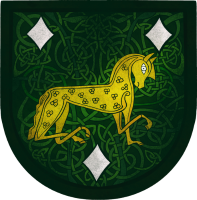A Sestina on a Journey
a new poem for Poeta Atlantiae 2021
upon the Coronation of Eckehard and Jane
Contents
Poem
Make in mind image of ancestral home:
a soothing, gentle, warm, and humble place.
Now open I the door, and stepping forth
into silence, I solemn stand alone,
seeing before me years, months, and minutes,
and leave on a long-expected journey.
I call discomfort friend on the journey,
where humpbacked ships are temporary home.
Scrunched by strangers, I make myself minute,
yet find comfort in this liminal place,
where we are all together but alone,
as the creaking carrack continues forth.
I find new friends along the Firth of Forth;
each one wanders on a diff’rent journey.
Clasping hands at ceilidhs, never alone
although outsiders from far remote homes,
we meet ourselves anew within this place,
laughing lose our past conceits in minutes.
My branching path turns in just a minute
as further functions call my footsteps forth.
Although upon these Crags I carved my place,
this is not the envoi of my journey.
Half a decade dear Dunedin was home,
but I must fly my friends and walk alone.
Upon another shore I stand alone:
watch the ebb and flow of waves and minutes.
While newer friends opened to me their homes,
I gather heart and hopes again for forth-
coming travel, another life’s journey,
my wistful transience now commonplace.
Now I know I may not find any place.
Each new land is briefly mine on a loan,
wonders engraved upon my heart’s journey.
Writing verse to act as mindful minutes
when memory fails, these words can bring forth
The dearest friends I found in far-flung homes.
I stay each place from years to mere minutes.
Alone, I open to strangers. Henceforth,
I gladly call this endless journey home.
Summary
The prompt for this poem was to “meditate on the experiences and/or lessons learned of a long voyage or time away.” Since long travel can takes us out of our comfort zones, I decided to take myself out of my poetic comfort zone by writing a sestina.
History and Form of the Sestina
Originating in the 12th century, the sestina was ostensibly created by Arnaut Daniel, a Provençal troubadour (“Poetic Formats,” “Sestina”). It found its way into Italian when it was adopted by Dante and Petrarch, and it was known in England by Elizabeth’s reign (“Forms of Verse: Sestina”). Comprised of six stanzas of six lines each, with an envoi/tornada of three lines, the line length varies depending upon the language: decasyllabic in English, hendecasyllabic in Italian, and alexandrine in French (“Poetic Formats”). While lines of a sestina can now be any length (“Sestina”), I chose to go with a loose iambic pentameter.
Though this structure seems quite straightforward, the difficulties of sestinas arise in the end-words. Usually unrhymed, the ends of the lines repeat the same six words in a different, highly structured order, with the envoi repeating three of the end-words and incorporating the other three internally (“Glossary,” “Poetic Formats,” “Sestina”). This list from Poets.org’s entry “Sestina” depicts the order, with each end-word represented by a letter:
1. ABCDEF
2. FAEBDC
3. CFDABE
4. ECBFAD
5. DEACFB
6. BDFECA
7. (envoi) ECA or ACE
Because of this, the form highly encourages wordplay to twist the end-words’ meanings.
Discussion
For my six end-words, I chose words that, to me, evoked the prompt: home, place, forth, alone, minute, and journey. I knew these words would allow for some fun wordplay, which I indulged in with “minute,” “forth,” and “alone.” I also allowed myself to pluralize some of these as needed.
The instant I chose “forth,” I knew part of the poem would need to be set in Edinburgh (also called Dunedin, verse 4 line 5), as the estuary it sits on is the Firth of Forth (verse 3 line 1). I decided it would be a sea journey via carrack (verse 2 line 6), which is a large sailing ship from the 14th and 15th centuries. This also led to the references to ceilidhs (Scottish social dancing events, verse 3 line 3) and the Salisbury Crags (verse 4 line 3), a significant geographical feature in Edinburgh. Indeed, verses 3 and 4 are quite personal; I lived in Edinburgh for five years, and made friends from all over the world (across Europe, but also New Zealand, Libya, and Maldives), many of whom I met through dancing and especially ceilidhs. Since I travelled often during those years, I had many opportunities to mull over the concept of liminal space (verse 2 line 4), which is as much a time as it is a location.
Finally, I couldn’t help but get a little meta with the inclusion of “envoi” (verse 4 line 4) and lines about writing verse in verse 5.
Overall, I’m pleased with how this sestina turned out. Pentameter is always a challenge for me, as I naturally think in four stresses (there’s a reason I write a lot of alliterative verse!). The strict organization of the sestina was an additional challenge, but I’m happy with how this late-period poem turned out. I hope to read it from the shores of the Forth someday soon!
Bibliography
“Poetic Formats in Contemporary Poetry: A How-To Guide: Sestinas.” Simmons University, 14 Dec 2019. https://simmonslis.libguides.com/c.php?g=989935&p=7160979
“Sestina.” Poets.org. https://poets.org/glossary/sestina
“Glossary of Poetic Terms.” Poetry Foundation, 2021. https://www.poetryfoundation.org/learn/glossary-terms/sestina
“Forms of Verse: Sestina.” Victoria & Albert Museum. http://www.vam.ac.uk/content/articles/f/forms-of-verse-sestina/
